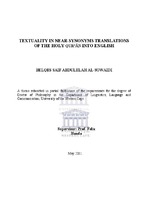| dc.description.abstract | The Holy Qurʾān, like the Bible, is an acknowledged literary masterpiece. Its linguistic and aesthetic vivacity with an amalgam of religious beliefs, moral values, religious social orthodoxy and historical backgrounds pose a great challenge to any translator and make the task overwhelmingly arduous, if not unattainable. The study aims at examining the problems the Qurʾān translators encounter while translating near-synonyms from Arabic into English. It is based on the translations of two professional translators namely, Yusuf Ali and T.B. Irving. The translations provide an empirical basis for the discussion of the problems while translating Qurʾānnic texts into English. The corpus for the present study includes the translations of four near-synonymous pairs namely, ghayth and maṭar,
al-ḥilf and al-qasm, bakhīl and shaḥīḥ and ʿāqir and ʿaqīm in their Qurʾānic context. The two translated texts are compared to determine to which extent the translations reflect the referential and the connotative meaning of the original Qurʾānic text as well as to which extent they maintain the textuality standards such as cohesion, coherence, informativity, situationality and acceptability, intentionality and intertextuality. In short, the study sets out to identify the roblematic areas in the translated Qurʾānic texts at the lexical and textual levels with a view to determining what makes one translation better than the other, or what brings one translation closer to the original text than the other.The study is an intersection between Qurʾānic exegeses (tafsīr) and applied linguistics. The researcher consults different books on translation theories as well as of Qurʾānic exegeses (tafsīr) to facilitate the process of analyzing the near-synonyms in their Qurʾānic context. The researcher opts for eclecticism, instead of confining to a particular rigid model or approach, which is a combination of text-analysis translation-oriented approaches of De Beaugrande & Dressler(1981); Neubert & Shreve(1992); Halliday (1994) and Hatim & Mason (1990). In addition, the study draws upon the multiple and theoretical implications of Nida's dynamic equivalence, Beekman & Callow's (1974) historical and dynamic fidelity and Gutt's (1991) relevance theory and the emphasis on communication as mainly context-dependent. These models are closely related and reliable in the process of analyzing and evaluating the problems encountered in Arabic-English translation of the Qurʾānic near-synonyms. Furthermore, the researcher suggests an outline approach for the process of analyzing the Qurʾānic near-synonyms translations in a systemic and organized way thereby ensuring maximum and effective communication of the Qurʾānic message. The study concludes that the Qurʾān translator, compared to other literary genres, faces many difficulties in translating the Qurʾānic ST message. The selected translations of the Holy Qurʾān have failed to measure up to the depth of the Qurʾānic message, its originality and the connotative shades of meanings of the original expression. The study attributes these problems to contextual, socio-cultural, theological and historical factors which create differences that lead to gaps or absence of lexicalization in the TT. Furthermore, the reliance on dictionary meaning rather than the meaning of the lexical item in context, the negligence of context culture as well as the context of situation (the reason for the revelation of the verses) affect the “periodicity” of the text as indicated by Martin & Rose (2007, p.187), that is, the information flow of the whole text. Accordingly, this affects maintaining the standards of textuality and the fidelity which a religious text should meet. The complexity of the Qurʾān as genre is a great challenge to the translator at both the lexical and Qurʾān textual levels, which dilutes the authenticity of the holy text and misrepresents its true message. The conclusion of the study which contains recommendations based on experience may prove helpful to the future novice and professional translators to improve the quality of translation in general and religious translation in particular. The study is a contribution towards a greater understanding of the subtle differences between the near-synonymous pairs in their Qurʾānic context through Arabic-English translation. It is a novel addition to the world of religious translation, Qurʾān translation, ḥadīth and in English. It also contributes to some extent to modern exegeses of the Qurʾān. It is hoped that the work will encourage further studies in the field of translation to employ a context-based linguistic approach to translating different genres and sacred texts in particular, integrating insights from applicable translation and linguistic approaches. | en_US |

